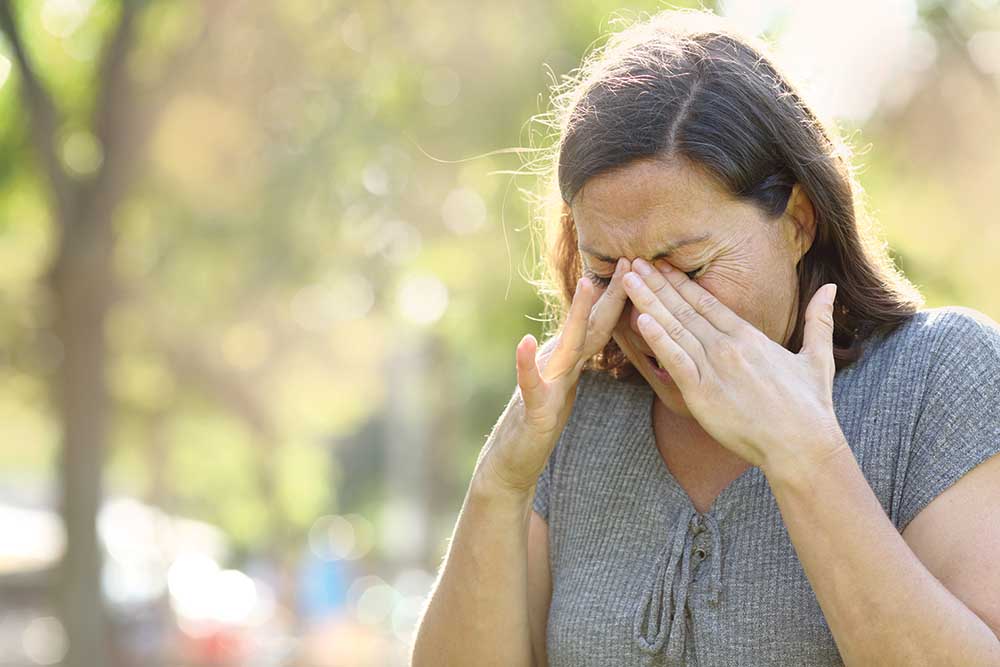Take Control This Winter
Submitted by VisionPoint Eye Center
As autumn settles in and colder weather approaches, many people notice an unwelcome change: eyes that feel gritty, irritated, or vision that becomes blurred. Winter is peak season for dry eye flare-ups. Low humidity, indoor heating, and wind all speed up tear evaporation, making this time of year especially challenging for anyone prone to dry eye.
Once considered a minor nuisance, dry eye has now reached the point of being classified as a disease—one that significantly affects the quality of life for millions of Americans.
“In the last decade or so, we’ve seen a huge upswing in dry eye disease,” says Dr. David Landess, optometrist and managing partner of VisionPoint Eye Center in Bloomington. “When you’re on a phone or computer, your blink rate drops by up to 50 percent. That lack of blinking is one of the underlying causes of dry eye.”
Why Blinking Matters
On average, we blink about 15 times per minute—roughly 15,000 times a day. Each blink helps the meibomian glands in the eyelids release oil into our tears. This thin oil layer slows evaporation and keeps vision stable. When blinking slows, those glands stagnate, become congested, and can eventually atrophy (shrink and lose function).
By the time symptoms such as burning, stinging, redness, itching, or light sensitivity appear, permanent damage may have already occurred. “Once those glands atrophy, you can’t fix them,” warns Dr. Landess. “It’s a permanent issue that often becomes symptomatic late.”
Who’s At Risk?
Nearly one-third of Americans have some form of dry eye, and about 30 percent of those people show no symptoms yet. While the disease isn’t a threat to sight itself, it can greatly impact daily comfort and visual clarity.
Screen time is a major risk factor, but age, certain medications, autoimmune disorders, and hormonal changes—especially in women—also increase the risk. Alarmingly, more teens and young adults are showing signs due to the constant use of digital devices.
The “Brown Grass” Effect
Dr. Landess compares untreated dry eye to a drought-stricken lawn. “You can water stressed grass and it will perk up, but once it’s dead, no amount of water will bring it back.”
Over-the-counter artificial tears may offer temporary comfort, but they don’t address the root cause—inflammation and gland dysfunction.
Catching It Early
The key to preventing irreversible damage is early detection. Two advanced tests, InflammaDry and TearLab, allow doctors to detect inflammation and tear film instability before symptoms become severe. “A positive test tells us treatment is needed,” says Dr. Landess.
Treatment Options
Treatment depends on the cause and severity and may include:
- Warm Compresses: An Optase Moist Heat Mask (available at VisionPoint Eye Center) can help decongest the meibomian glands and improve oil flow. The Hydrobead technology provides better heat retention for a more consistent and constant release of moist heat.
- Prescription Drops: Medications such as VeVye address inflammation and often provide relief within weeks.
- Intense Pulsed Light (IPL) Therapy: Originally used for skin conditions like rosacea, IPL has shown excellent results in managing dry eye. The light energy converts to heat, unclogging glands and closing abnormal blood vessels that trigger inflammation.
- Specialized Therapies: In advanced cases, options like serum tears (eye drops made from a patient’s own blood serum) can help support healing.
Prevention Tips
Whether or not you have symptoms, simple daily habits can protect your tear health:
- Take regular screen breaks using the 20-20-20 rule: every 20 minutes, look 20 feet away for 20 seconds.
- Use a humidifier to add moisture back into the air at home or work.
- Add healthy fats to your diet. Omega-3 fatty acids—found in salmon, walnuts, chia seeds, and flaxseed or fish oil supplements—can improve tear quality and reduce inflammation.
- Stay hydrated and avoid excessive use of antihistamines unless necessary.
Don’t Wait
“‘If only I had known sooner’ is something we hear often,” says Dr. Landess. “Once the damage is done, you can’t turn back the clock. But with today’s technology, we can often identify and address the root problem before it becomes irreversible.”
If you suspect you suffer from dry eye, schedule an evaluation with your eye doctor. Early action could mean the difference between years of irritation and a lifetime of clear, comfortable vision.
Your vision is an important part of your overall health. If you would like more information or to schedule a comprehensive eye health exam, contact VisionPoint Eye Center at (309)662-7700 or visit the website at visionpointeye.com. They are located at 1107 Airport Rd in Bloomington. Their ophthalmologists, optometrists, and opticians will be happy to see you.

